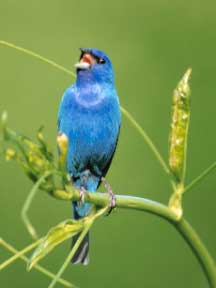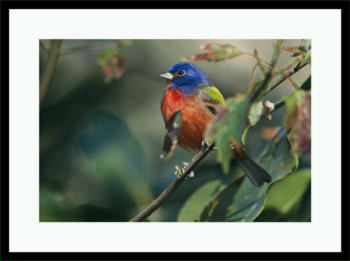|
Indigo and Lark
Buntings Rich in
Fabulous Color
|
|
Please Help Pets by Donating One Dollar
The male Indigo Bunting is a rich, deep blue all over, but
may appear dark and blackish in poor light.
Older male buntings are first to arrive on their North American
breeding grounds in late April to mid May. They will have already
staked out their territories by the time the females arrive
about two weeks later. Within a day or two, each female will
select a mate and settle on a particular territory where she
will most likely remain throughout the season. Together each pair
will raise as many as three broods.
80% of males learn their particular song by imitating an older
male with an established territory during their first spring
Between mid-August and November, with their breeding duties over
for the year, indigo buntings group together in large flocks and
abandon their northern quarters for the tropics
Picture Indigo Bunting

Indigo Buntings frequent forest clearings and second-growth habitat
in the East and Midwest.
Indigo Buntings are found in a variety of habitats but especially edges,
including roadsides and wood margins where there are brushy and weedy areas.
They are also common in old orchards and overgrown fields
if there are singing perches.
Song is composed of loud, strident high-pitched notes that
are often delivered in pairs.
It is one of the few birds that will sing persistently throughout
the hottest days of midsummer and by the end of the breeding
season the song is truncated, often consisting of no more than
three or four notes. The most common call is a dry chick, less
metallic and softer than that of blue grosbeak.
The Lark Bunting congregates in large flocks along roadsides.
The male is all black with a large white wing patch. The female
is similar to a female sparrow, a streaked sandy brown, white
below with a white eye line, white wing patch that is not always
visible and rounded white tipped tail feathers. Its melodious
song is a long and varied series of trills and notes.
This little bird ( 6 inches) inhabits grasslands and prairies
with its nest, an open cup of loose grass, on the ground.
The clutch size is 3 to 6 light blue eggs. The eggs are incubated
for 11 to 12 days. The young fledge in a little over a week.
There are one to two broods in a season.
Picture Painted Bunting

Buntings belong to the order Passeriformes.
Types of Buntings include:
Indigo Bunting
Lark Bunting
Lazuli Bunting
Painted Bunting
Snow Bunting
Varied Bunting
Index of Perching Birds
Terrific Stuffed Birds - the
Talk of the Aviary!
Festive Indigo Bunting Calendars
|